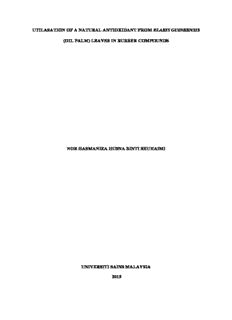Table Of ContentUTILASATION OF A NATURAL ANTIOXIDANT FROM ELAEIS GUINEENSIS
(OIL PALM) LEAVES IN RUBBER COMPOUNDS
NOR HASMANIZA HUSNA BINTI SHUHAIMI
UNIVERSITI SAINS MALAYSIA
2015
UTILASATION OF A NATURAL ANTIOXIDANT FROM ELAEIS GUINEENSIS
(OIL PALM) LEAVES IN RUBBER COMPOUNDS
By
NOR HASMANIZA HUSNA BINTI SHUHAIMI
Thesis submitted in fulfillment of the
requirements for the degree
of Master of Science
January 2015
DECLARATION
I declare that the content presented in this dissertation entitled “UTILASATION OF A
NATURAL ANTIOXIDANT FROM ELAEIS GUINEENSIS (OIL PALM) LEAVES IN
RUBBER COMPOUNDS” is own my work which was done at Universiti Sains Malaysia
unless onformed otherwise. This dissertation has not been previously submitted for any other
degree.
Saya isytiharkan bahawa kandungan yang dibentangkan di dalam disertasi ini bertajuk
“KEGUNAAN ANTI-OKSIDA SEMULAJADI DARIPADA ELAEIS GUINEENSIS
DAUN (KELAPA SAWIT) DI DALAM SEBATIAN GETAH ASLI” adalah hasil kerja
saya dan dijalankan di Universiti Sains Malaysia kecuali dimaklumkan sebaliknya. Disertasi
ini juga tidak pernah disertakan untuk ijazah yang lain sebelumnya.
Signature:
Candidate’s Name: NOR HASMANIZA HUSNA BINTI SHUHAIMI
Date:
Witness by,
Signature:
Supervisor’s Name: DR NADRAS OTHMAN
Date:
ACKNOWLEDGEMENT
Bismillahirrahmanirrahim,
First and foremost, I would like to show my deepest gratitude to the al-mighty
ALLAH S.W.T for giving me the chance to be able to complete my MSc program without
too much difficulty and stress. Thank you to Universiti Sains Malaysia (USM) and School of
Materials and Mineral Resources Engineering (SMMRE) for giving me some space to further
my study here.
I would also like to offer my deepest gratitude to my supervisor, Dr Nadras Othman
and my co-supervisor Professor Hanafi Ismail and Dr Sasidharan Sreenivasan (USM) for the
valuable guidance and advices while assisting me in completing my MSc program. I had
gained lots of knowledge which is ultimately useful for my future undertaking. It is my honor
to have a supervisor like them.
Apart from that, I would like to dedicate my special thanks to all the technicians and
staffs of SMMRE for sharing their experience and information beside unending assistance
during the completion of my project. I am very grateful to have a comfortable and warm
working place during my MSc Program. It is a wonderful experience to have cooperated with
all colleagues at the School of Materials and Mineral Resources Engineering.
Not forgotten, thanks to my family and all my friends for their support and
encouragements during the course of completing the task. Without the help and effort that
had been contributed by everyone, this project will not be successfully completed. I am really
thankful and truly appreciate all of their kindness.
My special thanks to The Yayasan Felda for the research grant
(305/PBAHAN/60501461) and Universiti Sains Malaysia for awarding me the Post-grad
Research Grant Scheme (1001/PBAHAN/8036014) which had supported me throughout the
completion of this thesis.
Last but not least, I would like to thank all individuals and organizations that had
directly or indirectly involved in the success of completing of my MSc project.
Table of contents
ACKNOWLEDGEMENT
TABLE OF CONTENTS iii
LIST OF TABLES viii
LIST OF FIGURES ix
LIST OF ABBREVIATIONS xvii
LIST OF SYMBOLS xx
ABSTRAK xxi
ABSTRACT xxiii
CHAPTER 1: INTRODUCTION
1.1 Preface 1
1.2 Problem statement 2
1.3 Objectives 4
1.4 Organization of the thesis 4
CHAPTER 2: LITERATURE REVIEW
2.1 Natural rubber (NR) 7
2.1.1 Origin of NR 10
2.1.2 General purpose of NR 13
2.2 Synthetic rubber 14
2.2.1 Type of synthetic rubber 14
2.2.1.1 Styrene Butadiene Rubber (SBR) 15
iii
2.3 Rubber compounding ingredients 16
2.3.1 Vulcanizing agent 17
2.3.2 Accelerator 18
2.3.3 Activator 20
2.3.4 Antioxidant 21
2.3.4.1 Chain breaking antioxidant 23
2.3.4.1 (a) Phenolics antioxidant 24
2.3.4.1 (b) Aromatic amines antioxidant 26
2.3.4.2 Synthetic antioxidant 27
2.3.4.3 Natural antioxidant 29
2.4 Rubber vulcanizations 30
2.5 Polymer degradation 31
2.5.1 Thermal oxidative degradation 32
2.5.2 Aging of rubber 35
2.6 Research background on effect of natural and synthetic antioxidant 36
CHAPTER 3: METHODOLOGY
3.1 Materials 39
3.1.1 Natural antioxidant preparations 41
3.1.1.1 Collection of oil palm leaves 41
3.1.1.2 Extraction of oil palm leaves in methanol 41
3.1.1.3 Characterisation of oil palm leaves extract using Fourier 42
Transform InfraRed (FTIR) Spectroscopy
3.2 Equipments 43
iv
3.3 Rubber compounding 44
3.3.1 Formulations 44
3.3.2 Compounding process 46
3.4 Cure characteristics 47
3.5 Vulcanizing process 47
3.6 Testing 48
3.6.1 Tensile and Tear test 48
3.6.2 Swelling test 49
3.6.3 Aging properties 50
3.6.4 Fatigue life 51
3.6.5 Compression set 51
3.6.6 Protein content 52
CHAPTER 4: RESULTS AND DISCUSSION
4.1 Characteristic of natural antioxidant (Elaeis Guineensis methanolic extract) 54
4.2 Effect of different vulcanization system on rubber vulcanizate in the presence 60
of natural antioxidant
4.2.1 Cure characteristic 60
4.2.2 Crosslink density 64
4.2.3 Tensile and tear properties 65
4.2.4 Percentage of retention 74
4.2.5 Fatigue life 80
4.2.6 Compression set 81
4.2.7 Comparative study with TMQ 82
v
4.3 Effect of natural rubber origin on rubber vulcanizate in the presence of natural 91
antioxidant
4.3.1 Cure characteristic 91
4.3.2 Crosslink density 96
4.3.3 Tensile and tear properties 97
4.3.4 Percentage of retention 102
4.3.5 Fatigue life 107
4.3.6 Compression set 108
4.3.7 Comparative study with TMQ 109
4.4 Effect different type of rubber (natural and synthetic) on rubber vulcanizate in 118
the presence of natural antioxidant
4.4.1 Cure characteristic 118
4.4.2 Crosslink density 122
4.4.3 Tensile and tear properties 123
4.4.4 Percentage of retention 129
4.4.5 Fatigue life 134
4.4.6 Compression set 135
4.4.7 Comparative study with TMQ 136
CHAPTER 5: CONCLUSIONS AND SUGGESTIONS FOR FUTURE WORK
5.1 Conclusions 147
5.2 Suggestions for future work 149
LIST OF PUBLICATION IN REFEREED JOURNAL 150
vi
LIST OF ATTENDED CONFERENCES (ORAL PRESENTATION) 151
REFERENCES 153
vii
Description:Materials and Mineral Resources Engineering (SMMRE) for giving me some space to further . 4.3.5 Fatigue life. 107. 4.3.6 Compression set. 108. 4.3.7 Comparative study with TMQ. 109. 4.4 Effect different type of rubber (natural and synthetic) on Chemical structure of cis-1,4 polyisoprene from NR.

